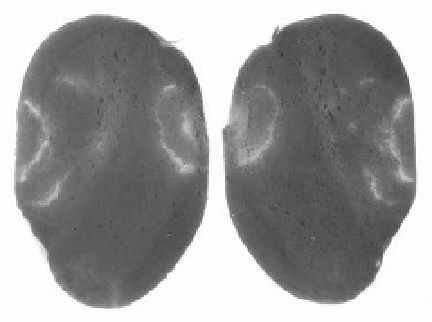Agriculture Reference
In-Depth Information
250
g of soil. However, when a combined infec-
tion occurs with other pathogens, the symptoms
and yield losses are more severe. For example,
the combined infection of
Verticillium
spp. and
Pratylenchus
spp., known as potato early dying,
has long been recognized as a problem of potato
production areas in the USA, often resulting in
yield reductions of
30-
50% (Powelson and
Rowe, 1993). In a greenhouse experiment, Hol-
gado
et al
. (2009) found that
P. penetrans
alone
induced tuber cross lesions similar to those of
common scab (
Streptomyces scabies
), but the
combined inoculation of the bacterium and the
nematode enhanced symptom expression.
The presence and survival of root-lesion
nematodes in tubers is a source for further
spread of these nematodes via seed potatoes
into new areas. Timing of harvesting to limit
damage, cold storage of tubers to reduce dam-
age, and ensuring seed is not infected are very
important. Traditionally, experience is required
to identify these nematodes using morpho-
logical characters. Several identification keys
are available that take into account biological
(presence/absence of males) and morphological/
morphometric characteristics for identification
(Castillo and Vovlas, 2007). Molecular tech-
niques can be very valuable in identification,
and several methods based on PCR have
been developed (Al-Banna
et al
., 2004; Oliveira
et al
., 2009).
Fig. 10.5.
Potatoes infected by
Tobacco rattle
virus
. (Photo courtesy of R. Neilson, The James
Hutton Institute, Invergowrie, UK.)
Spraing appears as noticeable brown rings on
the surface and/or brown arcs or flecking within
the tuber and mottle in the stems and leaves of
susceptible potato cultivars (Lamberti and Roca,
1987). Spraing symptoms in tubers, even at
relatively low levels, can render entire crops un-
saleable, for both the fresh and the processing
industries (Brodie
et al
., 1993; Scurrah
et al
.,
2005).
Trichodorid nematodes comprise different
taxonomic groups that are difficult to distinguish
visually, but which vary significantly in terms
of their distribution, pathogenicity, and virus
transmission frequencies and specificity with
the serotypes of virus they transmit (Ploeg
et al
.,
1992). The problem of their identification is
complicated by the coexistence of different spe-
cies in the same field.
Trichodorus
spp. occur pre-
dominantly in the more temperate regions,
whereas
Paratrichodorus
spp. are more prevalent
in tropical and subtropical regions (Luc
et al
.,
1990). The removal of approved nematicides
and the expected population increases with more
conducive conditions resulting from climate
change are expected to exacerbate difficulties
with their management in temperate regions.
Soil samples should be managed carefully
because of the nematode's delicate cuticle. Diag-
nosis of these nematodes is extremely difficult
and is based on morphological/morphometrical
characters (Decraemer, 1995).
Paratrichodorus
spp. are more difficult to identify than
Tricho-
dorus
spp. (Duarte
et al
., 2011). New diagnostic
methods based on DNA (specific primers,
qPCR, and RFLP PCR) have been developed for
Stubby-root nematodes,
Paratrichodorus
spp. and
Trichodorus
spp.
The stubby-root nematodes (
Paratrichodorus
spp.
and
Trichodorus
spp.) have wide host ranges and
feed on root surfaces, damaging the growing
tips, resulting in the formation of numerous
stubby roots. They are obligate ectoparasites
feeding primarily on the meristem cells of root
tips. As well as the direct damage caused to
roots, which results in yield and quality reduc-
tion, some trichodorid nematodes can transmit
plant viruses. Symptoms of stunting, wilting,
and lodging are usually patchy within the field,
and tend to be more severe in sandy soils. At
least
13
species of trichodorid nematodes can
transmit
Tobacco rattle virus
(TRV), which causes
spraing or corky ringspot in tubers (
Fig. 10.5
).

